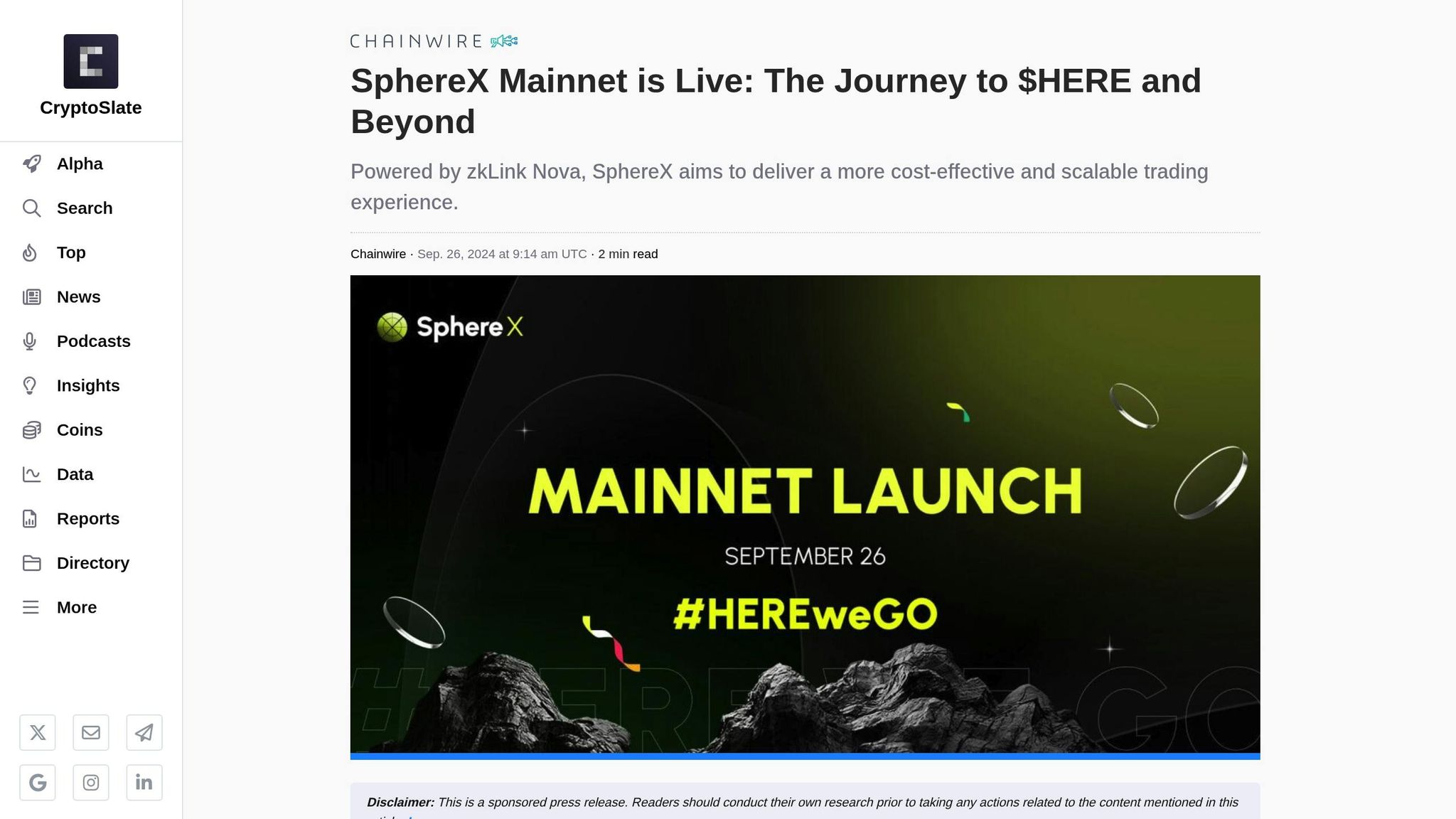Want to succeed in Web3? It starts with building strong stakeholder relationships. Whether you’re connecting with investors, institutions, or community members, effective engagement is critical for market access, funding, and growth. Here’s a quick guide to what you need to know:
- Key Stakeholders: Founders, investors, institutions, and community members all play unique roles in Web3 projects.
- Engagement Tactics: Use clear communication channels (like Telegram for quick updates), set measurable goals, and align incentives with token-based rewards.
- Partnerships: Collaborate with exchanges, grow developer communities, and work with agencies for fundraising and compliance.
- Tracking Success: Monitor KPIs like community growth, governance participation, and feedback to refine strategies over time.
Decentralized Innovation: Mihai Radu on SphereX’s Vision for …

Web3 Stakeholder Types and Roles
Understanding the key players in the Web3 space is essential for effective communication and collaboration. Knowing who these stakeholders are helps in crafting strategies that fit their specific needs and contributions.
Main Stakeholder Categories
The Web3 ecosystem includes several interconnected groups, each playing a crucial role:
Founders and Project Teams
- Lead technical development and define the project’s vision
- Manage tokenomics, governance, and strategic partnerships
- Engage with the community and oversee project integrations
Investors
- Provide funding, strategic advice, and industry connections
- Support projects through various growth stages
Institutions
- Offer trading and investment platforms
- Provide liquidity and market-making services
- Ensure compliance with regulations
- Handle large-scale transactions
Community Members
- Take part in governance decisions
- Contribute to development efforts
- Test features and share feedback
- Act as advocates for the project
How Web3 Stakeholders Differ
Stakeholders in Web3 operate in ways that set them apart from traditional systems:
Decentralized Governance
- Voting rights are tied to tokens
- Decisions are made collectively by the community
- Open systems allow anyone to submit proposals
- Approved changes are often executed automatically
Token-Based Incentives
- Tokens are distributed based on performance
- Rewards are given to long-term holders through staking
- Governance tokens grant voting power
- Liquidity mining programs encourage participation
Anonymous Participation
- Users often interact through pseudonyms
- Wallets serve as authentication tools
- Interactions require minimal trust
- Participation is open and permissionless
These distinct features provide a framework for engaging with each group effectively.
How to Engage Web3 Stakeholders
Effectively engaging Web3 stakeholders involves focusing on communication, setting clear goals, and offering meaningful incentives.
Communication Channels and Tools
For quick updates, Telegram is a great choice, while email works well for formal communication with investors. Once you’ve picked your channels, make sure to define clear metrics to measure engagement.
Setting and Tracking Goals
Set specific, measurable goals and track key performance indicators (KPIs). For example, monitor community activity on Telegram or gather investor feedback via email. Regularly review these metrics to ensure you’re on track.
Reward Systems that Work
Encourage long-term engagement by aligning stakeholder incentives. Combine token-based rewards with non-financial recognition, such as public acknowledgment or exclusive access to opportunities.
Consider using platforms like BeyondOTC (https://beyondotc.com) to connect with institutional networks, list opportunities, and directly link with investors to drive growth.
sbb-itb-7e716c2
Building Networks and Partnerships
After establishing strong engagement strategies, the next step is forming meaningful networks to amplify stakeholder impact. In the world of Web3, this requires a thoughtful approach and skilled collaboration across key areas.
Exchange and Platform Partnerships
Building relationships with centralized and decentralized exchanges is key to broadening your project’s exposure. To get started, ensure you have well-prepared documentation, including technical specs, security audits, and tokenomics details. Partnering with experienced agencies can simplify the process. For example, BeyondOTC has a solid track record in facilitating exchange partnerships.
Once these partnerships are in place, focus on strengthening ties with developers to keep your project moving forward.
Developer Community Growth
A strong developer community is essential for the success of any Web3 project. Hosting regular workshops and offering detailed technical documentation can attract top talent. Incentive programs are also effective for rewarding valuable contributions.
Take ChainSafe Systems as an example. In Q3 2022, they teamed up with BeyondOTC to secure $18.75 million in Series A funding, led by Framework Ventures. This funding helped them grow their team and accelerate the development of blockchain interoperability.
Working with Industry Agencies
Industry agencies can be game-changers when it comes to networking. In 2023, specialized agencies delivered impressive results in connecting projects to the right partners:
| Service Type | Impact Metrics |
|---|---|
| Transaction Volume | $55M+ in altcoins |
| Bitcoin Transactions | $250M+ |
| Project Connections | 23+ successful projects |
| Global Reach | 50+ countries |
When choosing an agency, look for one that offers a full range of services, such as:
- Fundraising advisory
- OTC trading solutions
- Legal compliance support
- Market entry strategies
- Access to established investor networks
BeyondOTC, for instance, has helped raise over $2 billion for its clients. With a global network spanning more than 50 countries, they provide tailored solutions to build effective partnerships and engage stakeholders. Working with the right agency can significantly expand your project’s reach and impact.
Tracking Engagement Success
Measuring Results and Getting Feedback
To gauge how well your engagement efforts are working, focus on clear KPIs tied to your goals. These should cover areas like community growth, governance participation, and development progress.
Using multiple channels can improve the quality of the feedback you gather. Here are some effective methods:
- Host regular community calls and conduct surveys to gather input.
- Leverage analytics tools to track both on-chain activities and social interactions.
- Centralize feedback collection to quickly address issues and concerns.
Updating Engagement Methods
As Web3 continues to grow and change, it’s important to adapt your engagement strategies. Use measurable outcomes to refine your approach over time. Keep improving by tracking key metrics, setting up direct feedback channels, and incorporating tools like real-time dashboards, automated rewards systems, and cross-chain integrations. These updates can help you stay aligned with the evolving needs of your community.
Conclusion
Engaging stakeholders effectively in Web3 requires a mix of technical understanding and strong relationship-building skills. As organizations navigate this evolving space, combining thoughtful strategies with flexibility helps create more meaningful networks and partnerships.
Specialized agencies like BeyondOTC provide projects with essential tools and resources to simplify their engagement efforts, leaving a lasting impact across the ecosystem. The balance between technological progress and authentic human connections is central to maintaining effective stakeholder relationships.
To strengthen stakeholder engagement in Web3, projects should focus on the following:
- Use real-time analytics and community feedback to refine strategies continuously.
- Adjust engagement approaches based on clear, measurable stakeholder input.
- Build diverse connections by leveraging established global networks.
- Prioritize transparency in communication and strategic planning.
As Web3 continues to grow, focusing on clear relationships and data-driven approaches will be key to achieving long-term success and sustainability in the digital asset space.




